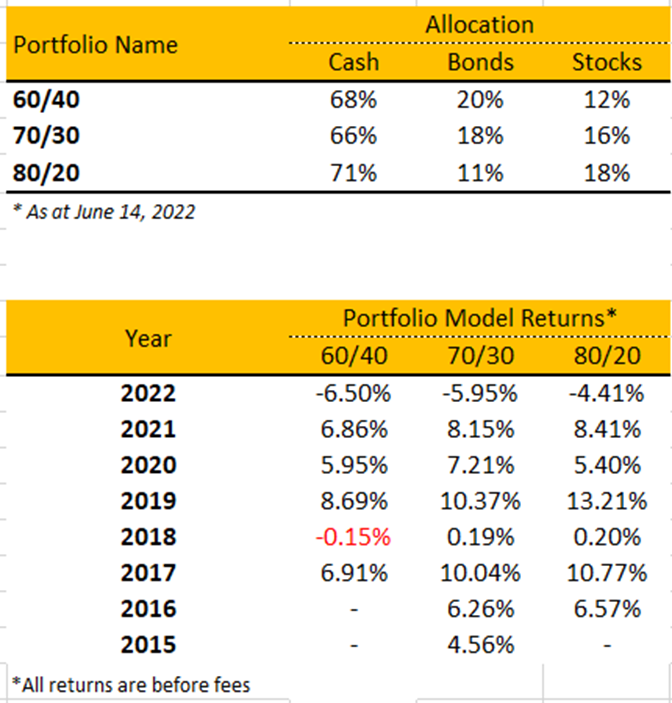June 2022 Update
Stephen Biddle - Jun 07, 2022
June is racing by and the market isn't slowing down. It seems every day is a new opportunity to change our investment strategy and we aren't wasting a moment.
Money is a tool. It's something that supports your life!
June is racing by and the market isn't slowing down. It seems every day is a new opportunity to change our investment strategy and we aren't wasting a moment. This month Stephen shares a few market insights in his Technical Comments, and we share an article written by Ben Carlson where he explains why we should "become more humble when the market is going against you... When human emotions grab the steering wheel it’s hard to say what’s going to happen." Ashley also shares her inflation woes and gives tips for younger investors on making your dollars stretch further through this recession-like time. And finally, we share our YTD Portfolio Performance. If you feel you have any friends who may benefit from our strategy, please feel free to send our performance along to them! Have a great start to summer, and enjoy this month's update!
Interesting Charts
1) Sentiment - Junk Bonds suggest an onslaught of corp defaul and downgrades. The myth of corp balance sheet strengh is about to be shattered spectacularly...
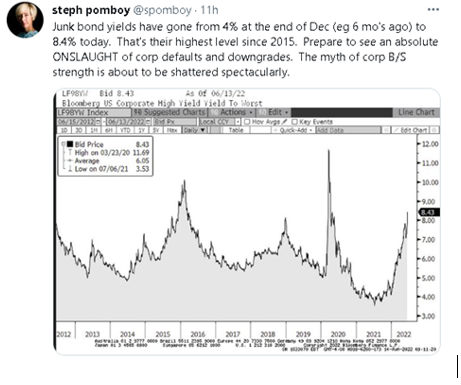
Twitter Post: June 14th, 2022
2) On this chart that would imply a P/E ~ 11x (current P/E is ~ 20x)
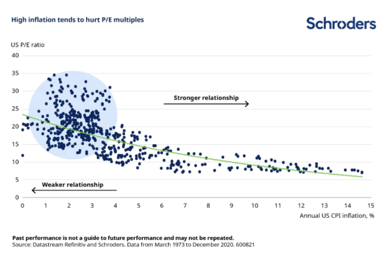
3) We're headed for a recession... and this could be a scary one...
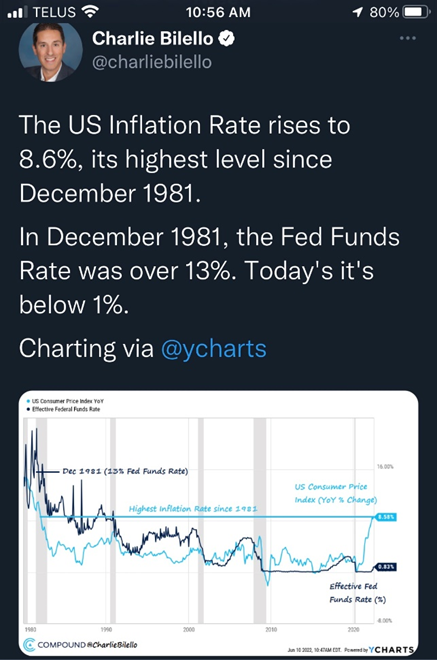
Twitter Post: June 10th, 2022
4) We've got a long way to go...
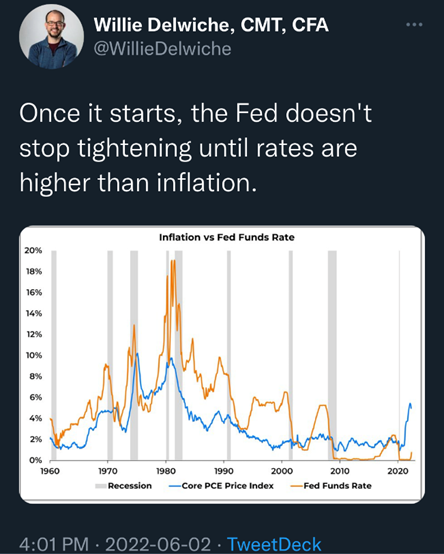
Technical Comments
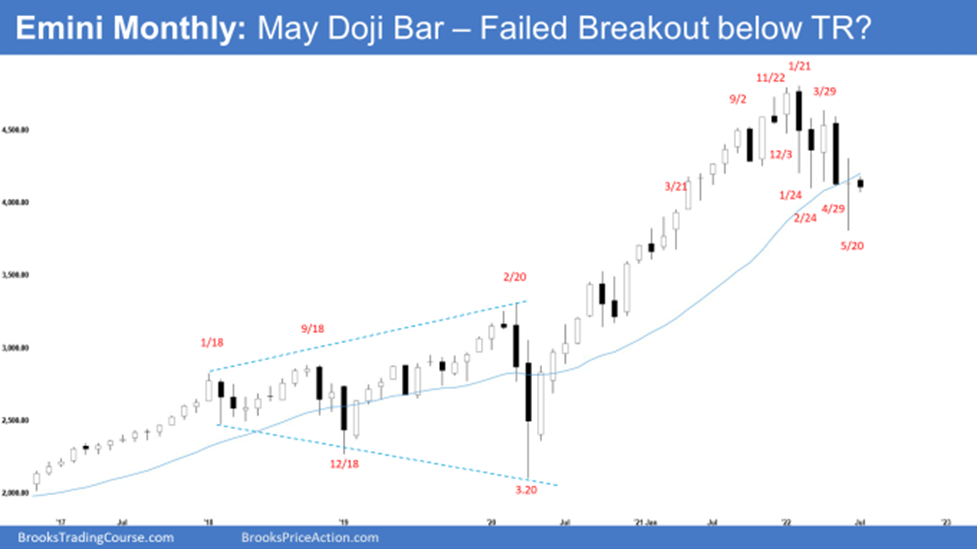
https://www.brookstradingcourse.com/price-action-trading-blog/
- Last month, we said that odds slightly favor May to trade at least slightly lower and that traders will be monitoring whether May closes as a bear follow-through bar, or reverses up from a failed breakout below the trading range low, to close as a bull bar.
- The bears see the move down in May as the second leg down from the January top. They want a measured move down to 3600 based on the height of the 9-month trading range height.
- Bulls want the breakout below the trading range low to fail and reverse back up. The bull’s case of a failed breakout would have been stronger if they have gotten a bull bar closing near the high.
- The targets for the bulls are May high and the middle of the 9-month trading range around 4400.
- We have said while the S&P 500 may test below the 9-month trading range, breakouts from a trading range have a 50% chance of failing. This remains true.
- Earlier, Al said that the February low did not quite reach the 20-month exponential moving average (EMA). Many traders would conclude that the average was not yet tested which increased the chance of the Emini going sideways to down until there is a low at least minimally below that average. That is one of the forces behind the current selloff.
- May has adequately tested the 20-month EMA.
- Al also said that the bull trend on the monthly chart has been very strong to make a bear trend on the monthly chart unlikely. This selloff should be a minor reversal on the monthly chart, which means the selloff will probably not go much below 3800 if it gets that far.
- The S&P 500 reversed up from around 3800 in May.
- The bears would have a better chance of a bear trend on the monthly chart after a test of the all-time high. Al has said many times that the S&P 500 should enter a trading range for about a decade within the next few years, but picking the exact high is impossible.
- It is always better to bet on at least one more new high. The trading range will probably have at least a couple of 30 – 50% corrections, like the trading ranges in the 2000s and the 1970s.
What's Hapenning
Increase Your Exposure to Humility During a Bear Market Posted June 14, 2022 by Ben Carlson
We’ve been in a bear market for a while now but never reached the technical definition of a 20% peak-to-trough drawdown in the S&P 500…until yesterday that is.
This is now the 13th decline of 20% or worse since World War II:
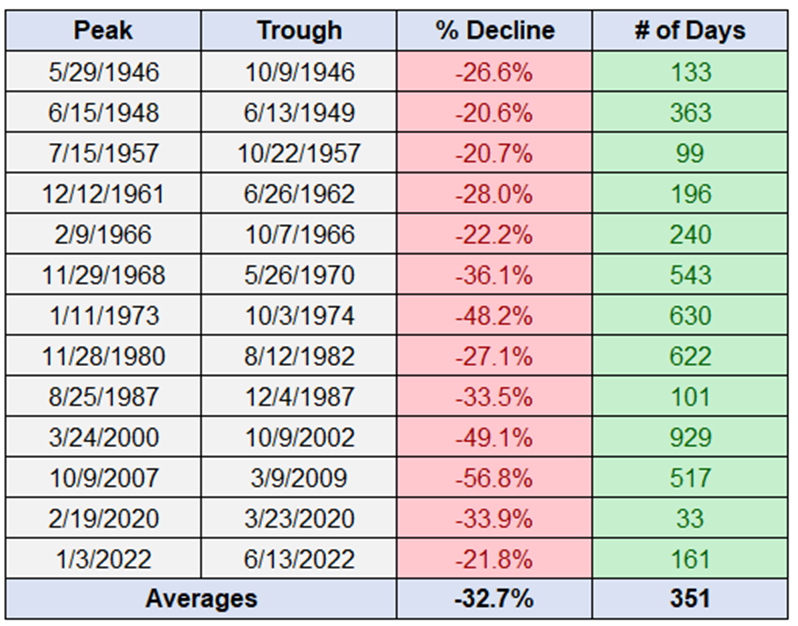
It’s currently the 9th longest bear market of the past 80 years or so.
The median decline for this herd of bears is -28% lasting 240 days.
All of these bear markets are unique in their own ways but this one has proved to be challenging on a number of fronts.
The Fed is feverishly trying to raise interest rates to tame inflation but market rates aren’t waiting around for the Jerome Powell and company to act.
Higher inflation and rising interest rates have also dinged the bond market:
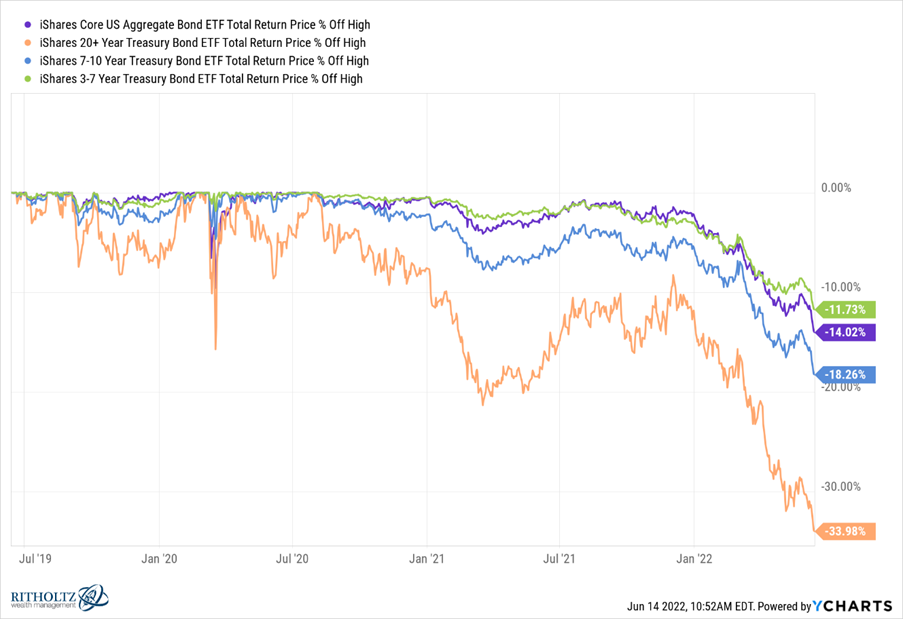
It’s telling that long-term bonds are in a bigger drawdown than any of the major stock markets right now:
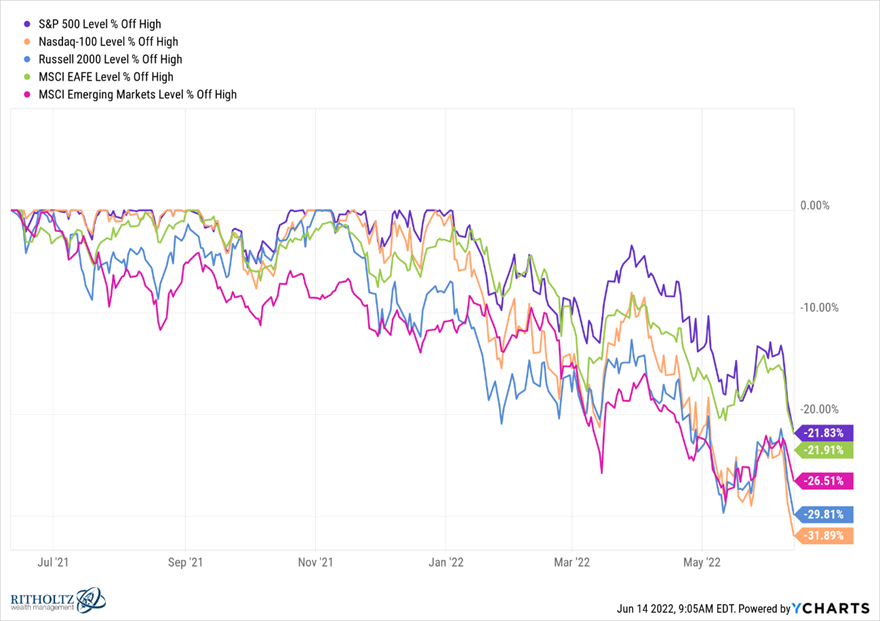
This makes sense when you consider the massive moves in interest rates this year.
These were the rates to start the year in January 2022:
-
2 year treasuries – 0.7%
-
5 year treasuries – 1.3%
-
10 year treasuries – 1.6%
-
30 year mortgage – 3.0%
And those same rates now:
-
2 year treasuries – 3.4%
-
5 year treasuries – 3.6%
-
10 year treasuries – 3.5%
-
30 year mortgage – 6.1%
We’re coming off a low base and inflation is still running much higher than interest rates but this is a massive move in a very short period of time. Usually the Fed comes to the rescue during a bear market. This time around, they’re causing it.
This bear market is certainly unique in terms of the bond market selling off alongside stocks but it does share some similarities to past bear markets.
Here is a look at how the current bear market matches up with the previous iterations in terms of interest rates and inflation at their peaks:
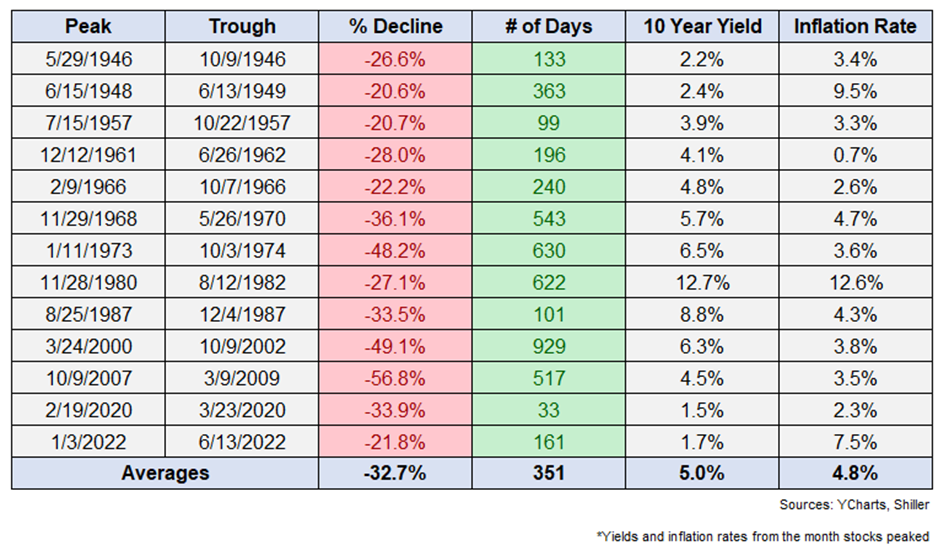
Following the wartime spending of the 1940s, inflation spiked but rates were relatively low.
But that was a much different economic environment and people were used to experiencing bouts of inflation.
The 27% bear market of the early-1980s was caused by Paul Volcker and the Fed to bring down runaway inflation from the 1970s.
But that was a much different interest rate environment and inflation had been high for more than a decade.
I like looking back at history to show that there is always a light at the end of the tunnel. Bear markets and recessions are a feature, not a bug, of this system.
However, this bear market feels different than anything we’ve experienced before. You have the aftershocks of the pandemic, a scorching hot labor market, interest rates that have effectively doubled in less than 6 months, war, record gas prices, record housing prices and a stock market that doubled in record time coming out of the last crash.
There are a lot of investors right now who believe this is a 2008-type event in the making.
Others believe this whole thing could be overdone if inflation is close to a peak.
I tend to get more bullish when stock prices are falling because it means expected returns are rising but I am well aware I have no idea what the future holds.
Bernard Baruch once said, “Become more humble as the market goes your way.”
I think you should become more humble when the market is going against you as well. When human emotions grab the steering wheel it’s hard to say what’s going to happen.
Famed investor Stanley Druckenmiller admitted at a recent conference appearance that he’s increasing his exposure to humility right now:
This is my 45th consecutive year as a Chief Investment Officer. In 45 years I’ve never seen a constellation or frankly studied one where there’s no historical analogue. Right now I probably have more humility in terms of my views going forward than I’ve ever had.
Things seem pretty terrible right now in the economy and the market but that doesn’t make it any easier to predict what comes next.
The Portfolios
*Hopefully everyone has had a chance to listen to our new Podcast Show - Market Commentary w/Ken&Stephen. We will have a new episode in July*
In May and June we have continued to sell equities and raise cash.
We have increased our cash weightings in our account to around 65-70%.
We have also decreased our bond waitings to almost half the allocation as rising interest rates hurt bond prices.
Once again, we have done a very good job of avoiding the down turn on the markets. As you can see the US markets are down double digits as are the bond markets
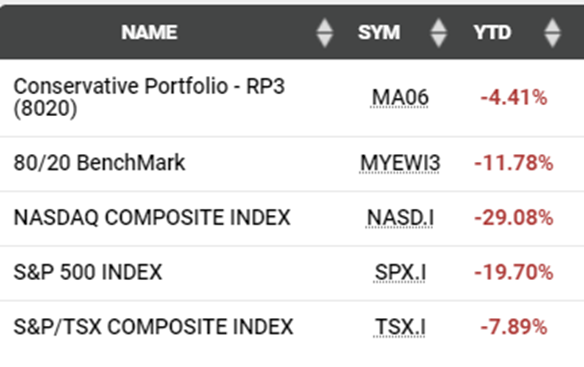
Returns on our 60/40, 70/30, and 80/20 Portfolios before fees:
Millennial Minute
Ashley types through her frustration with the current economic inflation this month. She shares how today's coniditions have made her rethink and re-evaluate her budget and financial goals.
Reviewing your spending plan is an important step to staying on track with your budget. You can read up on how she expects to survive the impending recession, and how she may rise above it! Click here to read more!


